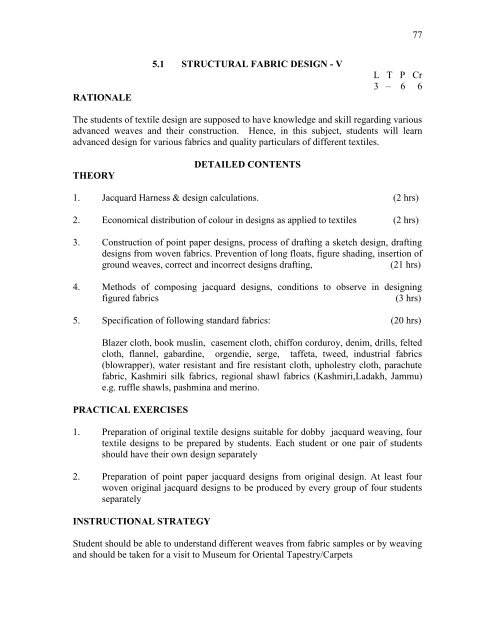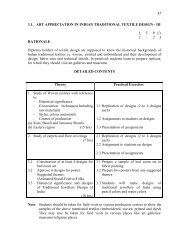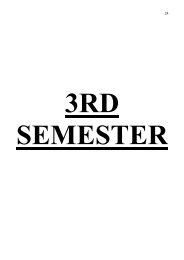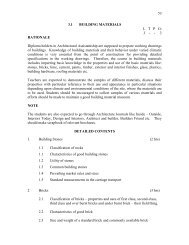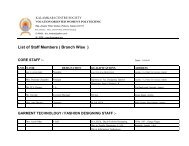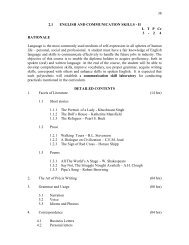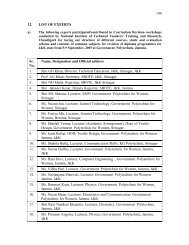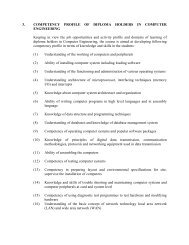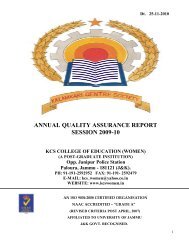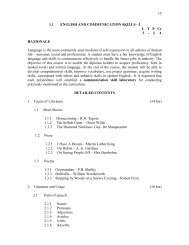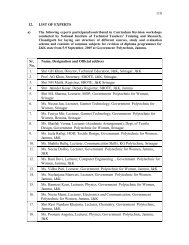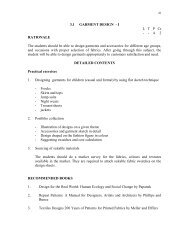6 6 RATIONALE The students of textile design are supposed
6 6 RATIONALE The students of textile design are supposed
6 6 RATIONALE The students of textile design are supposed
You also want an ePaper? Increase the reach of your titles
YUMPU automatically turns print PDFs into web optimized ePapers that Google loves.
77<br />
<strong>RATIONALE</strong><br />
5.1 STRUCTURAL FABRIC DESIGN - V<br />
L T P Cr<br />
3 – 6 6<br />
<strong>The</strong> <strong>students</strong> <strong>of</strong> <strong>textile</strong> <strong>design</strong> <strong>are</strong> <strong>supposed</strong> to have knowledge and skill regarding various<br />
advanced weaves and their construction. Hence, in this subject, <strong>students</strong> will learn<br />
advanced <strong>design</strong> for various fabrics and quality particulars <strong>of</strong> different <strong>textile</strong>s.<br />
THEORY<br />
DETAILED CONTENTS<br />
1. Jacquard Harness & <strong>design</strong> calculations. (2 hrs)<br />
2. Economical distribution <strong>of</strong> colour in <strong>design</strong>s as applied to <strong>textile</strong>s (2 hrs)<br />
3. Construction <strong>of</strong> point paper <strong>design</strong>s, process <strong>of</strong> drafting a sketch <strong>design</strong>, drafting<br />
<strong>design</strong>s from woven fabrics. Prevention <strong>of</strong> long floats, figure shading, insertion <strong>of</strong><br />
ground weaves, correct and incorrect <strong>design</strong>s drafting,<br />
(21 hrs)<br />
4. Methods <strong>of</strong> composing jacquard <strong>design</strong>s, conditions to observe in <strong>design</strong>ing<br />
figured fabrics<br />
(3 hrs)<br />
5. Specification <strong>of</strong> following standard fabrics: (20 hrs)<br />
Blazer cloth, book muslin, casement cloth, chiffon corduroy, denim, drills, felted<br />
cloth, flannel, gabardine, orgendie, serge, taffeta, tweed, industrial fabrics<br />
(blowrapper), water resistant and fire resistant cloth, upholestry cloth, parachute<br />
fabric, Kashmiri silk fabrics, regional shawl fabrics (Kashmiri,Ladakh, Jammu)<br />
e.g. ruffle shawls, pashmina and merino.<br />
PRACTICAL EXERCISES<br />
1. Preparation <strong>of</strong> original <strong>textile</strong> <strong>design</strong>s suitable for dobby jacquard weaving, four<br />
<strong>textile</strong> <strong>design</strong>s to be prep<strong>are</strong>d by <strong>students</strong>. Each student or one pair <strong>of</strong> <strong>students</strong><br />
should have their own <strong>design</strong> separately<br />
2. Preparation <strong>of</strong> point paper jacquard <strong>design</strong>s from original <strong>design</strong>. At least four<br />
woven original jacquard <strong>design</strong>s to be produced by every group <strong>of</strong> four <strong>students</strong><br />
separately<br />
INSTRUCTIONAL STRATEGY<br />
Student should be able to understand different weaves from fabric samples or by weaving<br />
and should be taken for a visit to Museum for Oriental Tapestry/Carpets
78<br />
RECOMMENDED BOOKS<br />
1. Watson’s Advance Textile Design<br />
2. Watson’s Textile Colour and Design<br />
3. Grammer <strong>of</strong> Textile Design by Nisbet<br />
4. Structural Fabric Design by Kilby<br />
5. Woven Structures and Design I and II by Davis Goerner<br />
6. Impressions – Master Pieces <strong>of</strong> Indian Textiles by K Prakash<br />
7. Shawls and Carpets <strong>of</strong> Kashmir by All India Handicraft Board, New Delhi<br />
8. Simple Fabric Structure by S S Satsangi<br />
SUGGESTED DISTRIBUTION OF MARKS<br />
Topic No. Time Allotted (Hrs) Marks Allotted (%)<br />
1 2 4<br />
2 2 4<br />
3 21 44<br />
4 3 6<br />
5 20 42<br />
Total 48 100
79<br />
5.2 FUNDAMENTALS OF KNITTING<br />
L T P Cr<br />
3 - 4 5<br />
<strong>RATIONALE</strong><br />
<strong>The</strong> aim <strong>of</strong> this subject is to impart knowledge and skills to the <strong>students</strong> regarding various<br />
types <strong>of</strong> knits and their use in the <strong>textile</strong> <strong>design</strong> as they may have to work in knitting<br />
industry and import and export houses as well.<br />
DETAILED CONTENTS<br />
Sr.<br />
<strong>The</strong>ory<br />
No.<br />
1. Comparison between knitted and woven<br />
fabrics, warp and weft knitting. Types <strong>of</strong><br />
knitting needles, their knitting cycle<br />
(18 hrs.)<br />
2. Weft Knitting<br />
Types <strong>of</strong> stitches: Knit, tuck, float, lay their<br />
representation, effects<br />
( 6 hrs.)<br />
3. Weft knit structures: Plain, Rib, Interlock<br />
and Purl, their characteristics<br />
(12 hrs.)<br />
Practical Exercises<br />
- Demonstration <strong>of</strong> different<br />
needles and their cycles<br />
- Yarn parameters for hosiery<br />
yarn<br />
Preparation <strong>of</strong> knit tuck and float<br />
stitches.<br />
Passage <strong>of</strong> yarn through Flat Bed<br />
and Circular Weft Knitting<br />
Machines<br />
4. Fabric defect in weft knitting (4hrs.) - Identification <strong>of</strong> fabric defects<br />
on the knitted fabrics<br />
5. Warp Knitting: Introduction to under lap<br />
and over lap, closed lap and open lap.<br />
Elementary idea <strong>of</strong> Tricot and Raschel<br />
machines<br />
(8 hrs)<br />
- Study <strong>of</strong> warp knitted samples<br />
with respect to the topics<br />
INSTRUCTIONAL STRATEGY<br />
Student may be asked to do the work on weft knitting machines and construct the lapping<br />
movement <strong>of</strong> warp knits.<br />
RECOMMENDED BOOKS<br />
1. Knitting technologies by D.B. Ajgaokar<br />
2. Knitting technology by Mark Spancer<br />
3. Textile Mathematics Vol III by J.E. Booth
80<br />
SUGGESTED DISTRIBUTION OF MARKS<br />
Topic No. Time Allotted (Hrs) Marks Allotted (%)<br />
1 18 38<br />
2 6 12<br />
3 12 26<br />
4 4 8<br />
5 8 16<br />
Total 48 100
81<br />
5.3 COMPUTER AIDED TEXTILE DESIGN - II<br />
<strong>RATIONALE</strong><br />
L T P Cr<br />
- - 6 3<br />
<strong>The</strong> term CAD has found its way into all major discipline that have got anything to do<br />
with <strong>design</strong>ing or drafting techniques. <strong>The</strong> major objective <strong>of</strong> this course is to expose the<br />
<strong>students</strong> to different s<strong>of</strong>tw<strong>are</strong>s available in the field <strong>of</strong> <strong>textile</strong> <strong>design</strong> industry so that they<br />
<strong>are</strong> able to use those s<strong>of</strong>tw<strong>are</strong>s in the <strong>design</strong> and construction <strong>of</strong> various <strong>textile</strong>s.<br />
Related <strong>The</strong>ory for Practical Exercises<br />
DETAILED CONTENTS<br />
1. Philosophy and utility <strong>of</strong> CATD system, working with various standard s<strong>of</strong>tw<strong>are</strong><br />
packages like photoshop, coral draw, NedGraphics, Auto Tex (for <strong>textile</strong> <strong>design</strong>)<br />
Nanos<strong>of</strong>t, Textronics<br />
2. Understanding graphic representation, file conversion, drawing simple geometric<br />
figures, capturing a single colour picture <strong>design</strong> using CCD/Scanner<br />
3. Use <strong>of</strong> computer to construct <strong>design</strong> on different bases with reference to various<br />
arrangements for woven <strong>design</strong>s<br />
4. Use <strong>of</strong> CATD in various end uses in single colour viz a viz dress material,<br />
upholstry, furnishing, label, & embroidery with the help <strong>of</strong> NedGraphics, Auto<br />
Tex (for Textile Design), Textronics<br />
PRACTICAL EXERCISES<br />
1. To draw 3 geometrical folk <strong>design</strong>s with Coraldraw<br />
2. To do colour ways <strong>of</strong> the Ex.1 using Coraldraw<br />
3. Create different textures for background and <strong>design</strong> using booties/natural objects<br />
which the student will create using digitiser<br />
4. Make 3 woven <strong>design</strong> for shirting material using different strips, checks, dals<br />
5. Do colour ways <strong>of</strong> Ex.4<br />
6. Scan a 10 inch x15 inch <strong>design</strong> and learn to stitch making a single image<br />
7. Design a logo for your production unit with written words also
82<br />
RECOMMENDED BOOKS<br />
1. CAD in clothing and <strong>textile</strong>s by W.Aldrich<br />
2. A magazine on Computer in the world <strong>of</strong> <strong>textile</strong>s<br />
3. NedGraphics<br />
4. Coral draw and Adobe Photoshop<br />
5. Wacom Digitiser
83<br />
5.4 TEXTILE TESTING AND QUALITY CONTROL - I<br />
<strong>RATIONALE</strong><br />
L T P Cr<br />
4 - 4 6<br />
Diploma holders in <strong>textile</strong> <strong>design</strong> <strong>are</strong> responsible for testing and quality control <strong>of</strong> yarn<br />
and fabric at the shop floor. Thus in this subject, student will be made fully aw<strong>are</strong> <strong>of</strong><br />
different quality standards and their maintenance during manufacturing processes for the<br />
total quality concept<br />
DETAILED CONTENTS<br />
Sr.<br />
<strong>The</strong>ory<br />
No.<br />
1. Textile testing - its aim & scope. Concept <strong>of</strong><br />
quality control and its importance. Methods <strong>of</strong><br />
quality control. Concept <strong>of</strong> ISO<br />
(8 hrs)<br />
Practical Exercises<br />
2. Importance <strong>of</strong> fixing standards. Brief idea <strong>of</strong><br />
factors responsible for deviation from standards.<br />
(6 hrs)<br />
3. Sampling techniques. Random and biased<br />
samples. Techniques for fabric sampling for<br />
specific tests.<br />
(8 hrs)<br />
Methods <strong>of</strong> yarn numbering system (dired<br />
4. Measurement <strong>of</strong> yarn number from large<br />
and small yarn lengths. Beesley’s and<br />
Knowle’s balance.<br />
(10 hrs)<br />
1.<br />
5. Yarn twist and its measurement, direction <strong>of</strong><br />
twists. Function <strong>of</strong> twist in yarn structure.<br />
Effect <strong>of</strong> twist on yarn Properties.<br />
Measurement <strong>of</strong> twist in single and ply yarns.<br />
(10 hrs)<br />
6. Chemical testing:<br />
Test <strong>of</strong> colour fastness for<br />
(a) Washing<br />
(b) Rubbing (Wet & Dry)<br />
(c) Dry cleaning<br />
(d) Perspiration (Alkaline & Acidic medium)<br />
Preparation <strong>of</strong> leas <strong>of</strong> different<br />
sizes on wrap reel<br />
Measurement <strong>of</strong> yarn number<br />
from large and small length<br />
samples - use <strong>of</strong> Knowle’s and<br />
Beesley’s balances<br />
Direct weighing methods and<br />
Analytical balance<br />
Measure <strong>of</strong> twist in single and<br />
folded yarns by twist testers.<br />
Use <strong>of</strong> laundrometer for wash<br />
fastness testing<br />
Crockmeter for testing <strong>of</strong><br />
rubbing fastness<br />
Demonstration <strong>of</strong> Grey scale &<br />
Blue scale.
84<br />
(e) Light<br />
(f) Chlorination.<br />
(10 hrs)<br />
7. Fibre Identification ( 2 hrs) - Microscopic test<br />
- Burning test<br />
- Solubility test<br />
8. Weight per sq. meters or per sq. yards ( 2 hrs) Quadrant balance<br />
a) For woven fabric<br />
(Temple <strong>are</strong>rectalar)<br />
b) For knitted fabric<br />
(Round cutter)<br />
9. Blend test by (Microscopic, burning and<br />
chemical processes).<br />
(6 hrs)<br />
Blend test by use <strong>of</strong> Microscope<br />
and solubility process.<br />
10. Air permeability test (2 hrs) Use <strong>of</strong> air permeability tester<br />
Note: All testing procedures <strong>are</strong> to be followed as per laid down standards by BIS.<br />
INSTRUCTIONAL STRATEGY<br />
Student must be taken to <strong>textile</strong> industries/Mills for practice and study <strong>of</strong> inspection and<br />
quality control operations<br />
RECOMMENDED BOOKS<br />
1. Textile Testing by JE Booth<br />
2. Textile Testing by Grover and Hambey<br />
3. Textile Testing by Angapan<br />
4. Textile Testing by John H.Skinkle<br />
SUGGESTED DISTRIBUTION OF MARKS<br />
Topic No. Time Allotted (Hrs) Marks Allotted (%)<br />
1 8 12<br />
2 6 10<br />
3 8 12<br />
4 10 18<br />
5 10 18<br />
6 10 18<br />
7 2 2<br />
8 2 2<br />
9 6 10<br />
10 2 2<br />
Total 64 100
85<br />
<strong>RATIONALE</strong><br />
5.5 TEXTILE FINISHING<br />
L T P Cr<br />
3 - - 3<br />
A diploma holder in <strong>textile</strong> <strong>design</strong> must have necessity knowledge and procedures used<br />
for finishing. For this, he should be acquainted with different types <strong>of</strong> processing <strong>of</strong><br />
finishing machines used for finishing. In addition, relevant skills also need to be<br />
developed in him about the operation <strong>of</strong> these machines.<br />
<strong>The</strong>ory<br />
DETAILED CONTENT<br />
1. Introduction, objects <strong>of</strong> finishing and its importance. (2 hrs.)<br />
2. Classification <strong>of</strong> various types <strong>of</strong> finishes (2 hrs.)<br />
3. Study <strong>of</strong> finishes with respect to the purpose, fabrics and reagents used. (2 hrs.)<br />
4. Textural finishes, their types and techniques (2 hrs.)<br />
5. Mechanical finishes and its applications (12 hrs.)<br />
- Sanforizing<br />
- Calendering<br />
- Crabbing and Milling<br />
- Anti-felting<br />
- S<strong>of</strong>tening<br />
- Decatising/blowing<br />
- Paper pressing<br />
6. Chemical Finishes (14 hrs.)<br />
- Water pro<strong>of</strong> and water repellent finishes<br />
- Flame retardant finishes<br />
- Soil release and soil repellent finishes<br />
- Antibacterial & moth pro<strong>of</strong>ing finishes<br />
- Crease/wrinkle resistant finishes<br />
7. Assessment <strong>of</strong> Quality <strong>of</strong> Finished Textiles (6 hrs.)<br />
8. Effluents and its treatments (6 hrs.)<br />
9. Latest developments in finishing<br />
(2 hrs.)
86<br />
INSTRUCTIONAL STRATEGY<br />
<strong>The</strong> <strong>students</strong> should be taken to <strong>textile</strong> industry to show them various processes <strong>of</strong><br />
finishing and its machinery so that they can know the various finishing processes being<br />
used by <strong>textile</strong> industry.<br />
REFERENCE BOOKS<br />
1. Technology <strong>of</strong> Finishing, Vol. 10 by VA Shenai and NM Sharaf,, Sevak<br />
Publication, Mumbai<br />
2. Textile Finishing by JT Marsh, BI Publications, New Delhi<br />
3. Effluents by ATIRA<br />
4. Textile Fiber to Fabric by Bernard P. Corbman, McGraw Hill International<br />
Editions<br />
5. Textile Finishing by Hall, AJ, Haywood Books, London<br />
6. Basic Water Treatment by Smethwurst G, IBT Publications, New Delhi<br />
7. Treatment <strong>of</strong> Textile Processing Effluent by Manivasaram N, Sakthi Publications,<br />
Coimbatore<br />
8. Production <strong>of</strong> Synthetic Fibres by Vaidya AA, Prentice Hall India Ltd., New<br />
Delhi<br />
9. Textile Auxiliaries and Finishing Chemicals by AA Vaidya and SS Trivedi,<br />
ATIRA, Ahmedabad<br />
SUGGESTED DISTRIBUTION OF MARKS<br />
Topic No. Time Allotted (Hrs) Marks Allotted (%)<br />
1 2 4<br />
2 2 4<br />
3 2 4<br />
4 2 4<br />
5 12 26<br />
6 14 30<br />
7 6 12<br />
8 6 12<br />
9 2 4<br />
Total 48 100
87<br />
<strong>RATIONALE</strong><br />
5.6 MANAGEMENT AND TEXTILE COSTING<br />
L T P Cr<br />
3 - - 3<br />
Management and costing assumes vital importance for a diploma holder in <strong>textile</strong> <strong>design</strong>.<br />
He must appreciate the value <strong>of</strong> leadership, motivation, human relations etc. because he is<br />
to work in team in a <strong>textile</strong> industry. Creating aw<strong>are</strong>ness regarding industrial legislation,<br />
environmental education and entrepreneurship will help the <strong>students</strong> to perform their jobs<br />
more effectively.<br />
THEORY<br />
DETAILED CONTENTS<br />
1. Introduction to Management, different functions <strong>of</strong> management: planning,<br />
organizing, coordination and control<br />
( 3 hrs)<br />
2. Management Structure <strong>of</strong> an industrial organization with relation to <strong>textile</strong><br />
industry<br />
( 2 hrs)<br />
3. Introduction to terms related to <strong>textile</strong> jobs ( 2 hrs)<br />
4. Objectives and procedure <strong>of</strong> job evaluation ( 3 hrs)<br />
5. Relations with subordinates, peers and superiors ( 2 hrs)<br />
6. Factors determining motivation ( 3 hrs)<br />
7. Methods for improving motivation ( 2 hrs)<br />
8. Need for leadership ( 2 hrs)<br />
9. Factors to be considered for accomplishing effective leadership ( 2 hrs)<br />
10. Importance and necessity <strong>of</strong> industrial legislation (for small and large scale<br />
industry)<br />
( 3 hrs)<br />
11. Accident and Safety Management – Accident and safety measures, fire prevention<br />
and precaution measures<br />
( 4 hrs)<br />
12. Sources <strong>of</strong> finances for projects ( 4 hrs)<br />
13. Merchandising: Importance and different independent activities <strong>of</strong> merchandising<br />
( 4 hrs)
88<br />
14. Basic concepts about different types <strong>of</strong> costs, like incremental cost, overhead cost,<br />
capital cost etc.<br />
( 6 hrs)<br />
15. Accounting concepts and financial statements (Highlighting balance sheet and<br />
income statement presentation<br />
( 6 hrs)<br />
RECOMMENDED BOOKS<br />
1. Principles <strong>of</strong> Management by Phillip Kotler<br />
2. Industrial Legislation and Labour Laws by F Cherunelam<br />
3. Accounting Methods by IM Pandey<br />
4. Cost Accounting for Beginners by B Datta<br />
5. Textile Management by VD Dudeja<br />
SUGGESTED DISTRIBUTION OF MARKS<br />
Topic No. Time Allotted (Hrs) Marks Allotted (%)<br />
1 3 6<br />
2 2 4<br />
3 2 4<br />
4 3 6<br />
5 2 4<br />
6 3 6<br />
7 2 4<br />
8 2 4<br />
9 2 4<br />
10 3 6<br />
11 4 8<br />
12 4 9<br />
13 4 9<br />
14 6 13<br />
15 6 13<br />
Total 48 100


